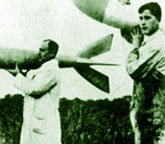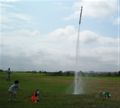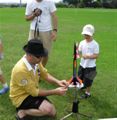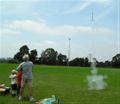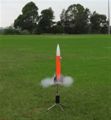Date: 9th December 2007,
9am - 1:30pm
Location:
George Kendall Reserve
Conditions:
22 degrees C, Easterly at 0-10km/h,
overcast
Team Members at
Events:
GK, PK, Paul K, John K,
JordanK, IK, HK, AK
This week we tried a new launch site that
is a little bigger than where we normally
launch. We arrived at the George Kendall
Reserve at 9am, for a later start than
normal as we brought the whole family along,
and had further to drive. It was overcast
but there was only a slight breeze. The only
minor issue were the patches of standing
water from the previous day's rain. We also
met up with David and Darren from the
Forum for Australian Rocketry and they brought
their pyro rockets along. We really enjoyed
the day.
Flight Day Events
Polaron IV development
We have been focusing development on
Polaron IV over the last few weeks. There is
a lot to get done because the rocket
yet again requires a new launcher. We have now done the final technical
drawings of the components we need to make
and have started
manufacturing them. We pretty much
have all the materials on hand and are
looking forward to getting this thing up and
flying.
Payload Section
The entire rocket will now be placed dry
onto the launcher. This is because it will
take a little time to align and be seat
everything
properly. Because the boosters can be filled
from the top there was no issue, but the
main stage was normally filled through the
nozzle. The rocket will now be configured so
that it can be filled from the top as well. Filling
it from the top poses a problem, because the
payload section is in the way. So we have made the
payload detachable allowing us to fill the
stage with water, capping it and then
locking the payload into place.
Main stage
The main stage parachute will be
upgraded to the one used by
Acceleron
II. The smaller 42cm parachute isn't
enough to bring this heavier rocket down. We
have flown a rocket of this size with twin
chutes, but the single larger chute is
simpler.
Because we are using the 2 liter bottles
for this stage, we have decided to use the
reinforcement technique discussed on
day 49
to reinforce the base only. On about 3
occasions we have had failures at the
coupling hole, and this reinforcement
attempts to prevent that from happening. We
have slightly amended the procedure
discussed previously and now pressurize the
bottle to about 10psi while shrinking the
outer sleeve.
Launcher
This launcher will again be a universal
launcher that will enable rockets of various
sizes with three
boosters and a main stage to be launched
simultaneously. Single stage rockets may
also be launched from the launcher.
Dad made up the necessary air supply
system for the launcher with a number of
gauges, valves, a pressure regulator, check
valves and bleed valves. All these are
mounted on the side of the ground
transportation vehicle for now, before we
fit them in a nicer self contained box. The
new pressure regulator also allows us to go
to about 25 bar (360psi), almost double that what the
previous one could do. This new air supply
system allows us to use a scuba tank
to supply differing pressures to the boosters
and to the main stage.
Flight Details
| Launch |
Details |
| 1 |
|
Rocket |
|
J4
IV |
|
Pressure |
|
120 psi (8.3 bar) |
|
Nozzle |
|
9 mm |
|
Water |
|
1.25 L + foam |
|
Flight Computer |
|
V1.3.2 - Setting:
"9" |
|
Payload |
|
Altimeter, Camera,
padded nosecone extension. |
|
Altitude / Time |
|
397' (121m) / 22.4 s |
|
Notes |
|
Very good vertical flight,
with good deploy and good landing.
Camera recorded flight. |
|
| 2 |
|
Rocket |
|
J4
IV |
|
Pressure |
|
130 psi ( 9 bar ) |
|
Nozzle |
|
9 mm |
|
Water |
|
1.25 L + foam |
|
Flight Computer |
|
V1.3.2 - Setting:
"10" |
|
Payload |
|
Altimeter, Camera,
padded nosecone extension. |
|
Altitude / Time |
|
? / ? |
|
Notes |
|
Very good flight
again mostly vertical. Good deploy
and good landing. The altimeter was
not functional on this flight.
Camera recorded flight. |
|
| 3 |
|
Rocket |
|
J4
IV |
|
Pressure |
|
130 psi ( 9 bar ) |
|
Nozzle |
|
9 mm |
|
Water |
|
1.25 L + foam |
|
Flight Computer |
|
V1.3.2 - Setting:
"10" |
|
Payload |
|
Altimeter, Camera,
padded nosecone extension. |
|
Altitude / Time |
|
? / ? |
|
Notes |
|
Good flight, not
quite vertical and a good landing.
The altimeter was not functional on
this flight. Camera recorded flight. |
|
| 4 |
|
Rocket |
|
J4
IV |
|
Pressure |
|
130 psi ( 9 bar ) |
|
Nozzle |
|
9 mm |
|
Water |
|
1.25 L + foam |
|
Flight Computer |
|
V1.3.2 - Setting:
"10" |
|
Payload |
|
Altimeter, Camera,
padded nosecone extension. |
|
Altitude / Time |
|
242' ( 74m ) / ? |
|
Notes |
|
Launched with
slightly bent payload section.
Rocket pitched over very soon after
takeoff and flew closer to
horizontal than vertical. Altimeter
recorded flight, and camera also
recorded flight. |
|
| 5 |
|
Rocket |
|
J4
IV |
|
Pressure |
|
130 psi ( 9 bar ) |
|
Nozzle |
|
9 mm |
|
Water |
|
1.25 L + foam |
|
Flight Computer |
|
V1.3.2 - Setting:
"10" |
|
Payload |
|
Altimeter, Camera,
padded nosecone extension. |
|
Altitude / Time |
|
371' ( 114m ) /
? |
|
Notes |
|
A similar flight to
#4, rocket pitched over after
takeoff and headed long way down
range. Altimeter recorded flight,
but the camera did not record. |
|
|


